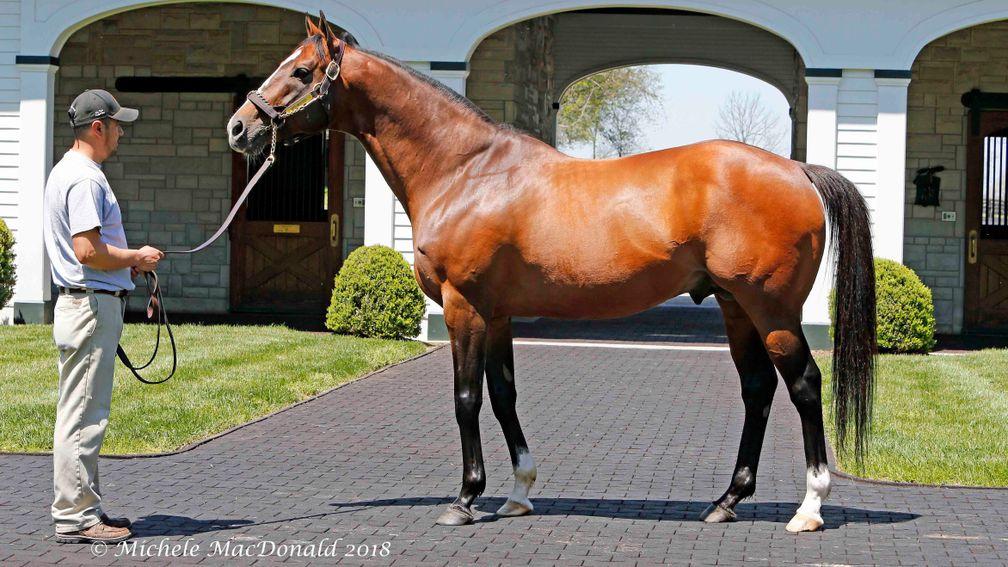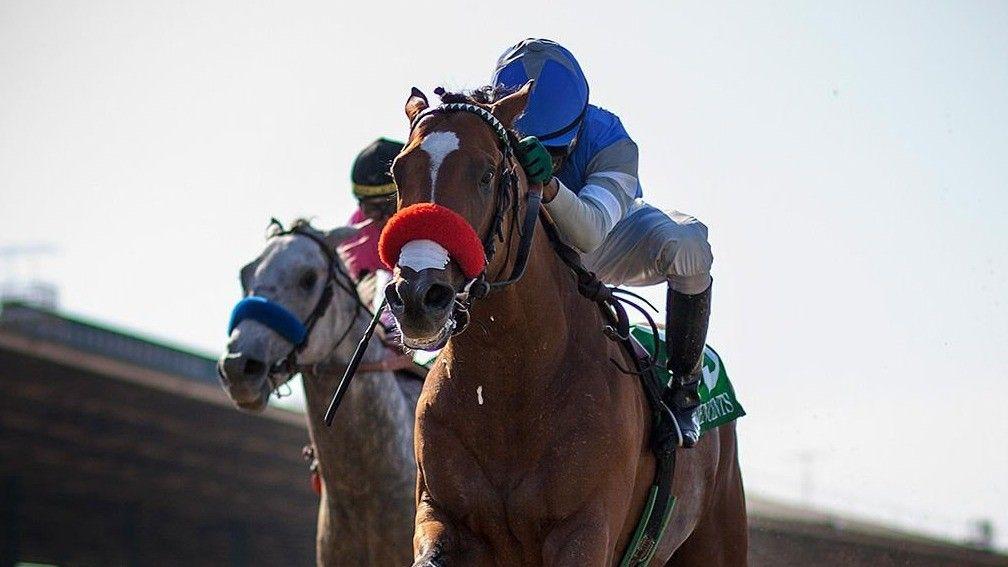Spendthrift and breeders sharing the upside with Into Mischief
Michele MacDonald talks to Ned Toffey about the sire sensation

Hustling to attract breeders to a stallion few held in high regard, eight years ago B Wayne Hughes’s Spendthrift Farm in Kentucky created an incentive programme called Share the Upside.
For a total of $13,000 for two seasons over two years, breeders could obtain a lifetime breeding right in the stallion, a juvenile Grade 1 winner Spendthrift had raced after purchasing for $180,000 at an Ocala Breeders’ Sales breeze-up auction in 2007.
Fast forward to a lottery-style jackpot. Today the horse that no-one wanted to breed to has emerged as one of the world’s most prominent sires - Into Mischief - and the programme has been copied and exported while also igniting the distribution of more breeding incentives.
“Share the Upside has been a positive change for the business because it’s sparked competition among the farms,” says Spendthrift general manager Ned Toffey of the simple yet innovative concept that was initially designed to get more mares for Into Mischief, who in 2010 was entering his second year at stud, and another Spendthrift stallion in Notional.
At the time, breeders were decidedly sceptical about Into Mischief and uncertain about the Share the Upside programme, but both are now firmly established pillars of American breeding.
“The programme did help supplement his book just enough to give him the statistics to be successful," says Toffey. "Into Mischief has been a remarkable horse and his success came from relatively small books early.
“His percentages [of top runners] are just uncanny. He’s been hugely successful. I think there’s no question that Share the Upside has helped that.”
When he was first retired to stud, Into Mischief could not claim the same genetic appeal that he can now through his ascendant pedigree. His younger half sister, the Spendthrift-owned Beholder, became a four-time champion, and his still younger half-brother Mendelssohn won the Breeders’ Cup Juvenile Turf last year and the valuable UAE Derby this season for Coolmore.
However, Into Mischief’s offspring speak just as convincingly on his behalf.

A 13-year-old son of Harlan’s Holiday and the 2016 American Broodmare of the Year Leslie’s Lady, Into Mischief led all American sires of juveniles in 2016 and followed up that achievement as the leading sire of three-year-olds in 2017.
So far this year, he ranks fifth on the North American general sire list, ahead of the likes of Tapit, Medaglia D’Oro, War Front and Uncle Mo.
He is also responsible for one of the most talked about two-year-olds to have raced in the US in 2018, $1.2 million purchase and ten-length Los Alamitos debut winner Instagrand.
Rags to riches
The lifetime breeding rights earned by those who subscribed to the Share the Upside programme by breeding two mares to Into Mischief over the span of the 2010 and 2011 seasons now trade at around $400,000 or more, Toffey says.
So few mares were sent to Into Mischief in the year Share the Upside was created that there were only 27 foals born the following season who eventually were named. It is ironic, then, that he covered more mares in 2017 than any other stallion in North America with 235.
He covered a similar number this year, many at a fee of $100,000 after his book opened at $85,000, and Toffey says a limited number of 2019 seasons are currently being offered at $125,000, with Spendthrift planning to adjust upward if the demand warrants.
“I suspect he’s going to be extremely popular at that number,” Toffey says.
Into Mischief, now a primary heir of the legacy of his great-grandsire Storm Cat, has become such a big star that some of his strongest initial supporters find he no longer fits in their breeding plans because his fee has risen so high.
“He’s out of our zone now,” says Pam Robinson, a commercial breeder who operates Brandywine Farm with her husband Jim. “It happens so infrequently that a horse moves so far up, but he’s earned it.”
The Robinsons have supported Into Mischief as much as anyone outside Spendthrift, and they earned a pair of lifetime breeding rights through the Share the Upside programme.

Branydwine’s Into Mischief investment continues to reap dividends as the farm still has three yearlings by the sire to sell this year at auction and several foals born this spring.
“They typically look to be sprinters or maybe milers," Robinson says. "His offspring all have good conformation and good minds and balanced frames."
Mentally tough
Into Mischief tends to pass on his own characteristics in large measure.
“He is very mentally tough, although very good to be around, and very, very intelligent," says Toffey. "He’s such a consistent sire, in large part, because so many of his horses approach their job professionally. They’re tough, they like what they do and go out and perform."
Toffey predicts more Classic runners by the sire will emerge from the better mares that have been bred to him as his stud fee has increased.
“As Into Mischief’s mare quality improves, I think you’re going to see more Classic-type horses,” he says. “You saw Audible [Into Mischief’s Grade 1 Florida Derby-winning son] finish third in the Kentucky Derby this year and I think you'll see more.”
Although his early books of mares may have been relatively very small, Into Mischief now has seven crops of racing age with a total of 627 foals, or an average of about 89 per crop.
Even including the mostly still unraced 158 juveniles of 2018, Into Mischief has conjured a strong six per cent stakes-winners from those foals.
Into Mischief’s stature is also growing through the success of his son Goldencents, one of 42 named foals from his first crop. Twice a winner of the Breeders’ Cup Dirt Mile, Goldencents was recruited to stand at Spendthrift and he currently leads all North American freshman sires by both progeny earnings and winners.
“Goldencents begins to put Into Mischief into the category of a sire of sires,” Toffey says. “There’s a pretty short list of horses that fall into that category, and that just shows you how remarkable a horse Into Mischief is.”
Additionally, Goldencents is continuing to elevate the Share the Upside programme, and some of Into Mischief’s early supporters, including Brandywine, are patronising him as well.
Taking care of breeders
Toffey notes that Spendthrift decided in 2011 to make all its new stallions part of Share the Upside going forward, with the possible exceptions of some that might be owned in partnership.
Spendthrift owner Hughes “has always felt strongly that we need to take care of the small breeders, and really all of our breeders - they’re the backbone of our industry," Toffey says.
"It doesn’t much matter who is standing these stallions if there's nobody around to breed to them,” he adds. “That’s some of the thinking that led to the Share the Upside programme.”
When Hughes opened a Spendthrift branch in Australia, the farm began the programme there as well, although only with Australian-raced horses and not with shuttlers, who might not be able to return to duty down under due to health or other reasons, Toffey explains.
Two new stallions at Spendthrift’s Australia farm for the 2018 breeding season, Group 2 winner Gold Standard (by Sebring) and multiple stakes winner Overshare (I Am Invincible) are both offered in the Share the Upside plan.
Group 1-placed Swear, by Redoute’s Choice, has also been part of the Share the Upside programme.
“It’s gone down well," says Toffey. "Just as it was here, it was a tough sell initially - it was an idea people weren’t used to and on top of that, in Australia they weren’t used to us, period."
Australians are adapting to the concept, as did Americans - even competitors in the stallion business.
Darby Dan Farm in Lexington launched its own Share the Upside in 2012 and added Grade 1 winner Dialed In to the programme when he stood his first season in 2013 at a fee of $7,500. A son of Mineshaft, Dialed In reigned as the leading North American freshman sire of 2016 and stood for $25,000 this year.
“Farms have become creative in some of the different discounts or incentives they’re offering, and a number of farms have emulated what we have done,” Toffey says. “[Darby Dan owner] John Phillips was kind enough to approach Mr Hughes and ask if he minded if he copied the program, and Mr Hughes was delighted for him to do it.
"It’s not something we’ve ever thought about trademarking or anything. We think it’s a great thing for breeders.”
Onwards and upwards
Spendthrift intends to continue with Share the Upside. Typically, the farm aims for no more than about half the number of seasons in a young stallion’s total book, in general terms around 75 of 150 seasons, to be sold under Share the Upside, retaining potential future benefit for the farm as well.
Toffey says: “We’re constantly evaluating and tweaking and trying to find what is best for the breeders and for us as a farm. But we think it’s a great way to incentivise people to help be invested in the horse and have a chance to kind of ride the wave of success and hopefully do all they can to help contribute to that success.
"It’s difficult to come up with a really good stallion, so when you do, you want to be in a position to capitalise, and I think this programme allows people to do that. And it really helps stallions get a good, solid book of mares for the first couple of years.”
While so much cannot be known or predicted in the breeding business, Toffey says there is one certainty.
“I know the one thing a stallion most needs to be successful is opportunity,” he opines. “If we can give these horses opportunity, they’ve shown that good sires can come from any place. And quite frankly, they pretty regularly do.
"It’s not just that it can happen, it does happen quite routinely.”
Into Mischief, even with very limited opportunity early in his stud career, is living proof.
If you enjoyed reading this, you might also like...
Kitten's Joy purring away nicely in his new life at Hill 'n' Dale
Exciting times ahead as Arrogate signals a new era for Juddmonte
Up close and personal with Songbird on fan appreciation day
Published on 2 August 2018inNews
Last updated 01:31, 2 August 2018
- ‘It’s been constant pressure for the last six months’ - up-and-coming consignors out to make dreams come true at the Doncaster Breeze-Up Sale
- Three new board members for the National Stud
- Hide The Evidence a first winner for Sands Of Mali with victory at Bordeaux Le Bouscat
- Showcasing filly from a deep Moyglare family set for Gowran Park debut on Tuesday
- Little Big Bear's brother and close relation to Unquestionable face off in Curragh maiden on Sunday
- ‘It’s been constant pressure for the last six months’ - up-and-coming consignors out to make dreams come true at the Doncaster Breeze-Up Sale
- Three new board members for the National Stud
- Hide The Evidence a first winner for Sands Of Mali with victory at Bordeaux Le Bouscat
- Showcasing filly from a deep Moyglare family set for Gowran Park debut on Tuesday
- Little Big Bear's brother and close relation to Unquestionable face off in Curragh maiden on Sunday